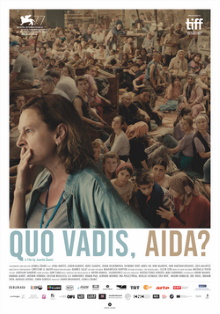The Srebrenica massacre took place more than 25 years ago. I suppose it took this long for a major film about the event to be made. Yet watching it today feels extra meaningful due to the ongoing war in Ukraine. This film focuses on the perspective of a single fictional character and her family, while being very light on any exposition about the larger conflict. As a dramatic work, it is unquestioningly brilliant in putting the audience in the shoes of the hapless civilians who are powerless in the face of the disaster and death all of them can see coming towards them. Yet there is so little information about what is really going on that it can at times be very frustrating.
Former schoolteacher Aida Selmanagić is a Bosniak translator working for the UN Protection Force in Srebrenica. Together with the other civilians, they express their concerns about the approaching Serb forces to Thom Karremans, the Dutch commander of the UN Forces. Karremans assures them that Srebrenica is a safe zone and that UN forces will launch air strikes against the Serbs if they attack the city. Yet the UN does nothing when the Serbs, led by General Mladić, attack, and large numbers of Bosniak civilians head to the UN base for protection. When Karremans’ calls for help up the chain of command go unanswered and the Serbs surround the base, Aida is forced to prioritize the survival of her own family including her husband and two sons. The Serbs promise the Bosniaks that civilians will be evacuated safely but their arrogant and bullying attitude even towards the Dutch soldiers assure no one and Aida does everything that she can to keep from being separated from her family.
Everyone who sits down to watch this film knows how it ends: more than 8,000 Bosniak Muslim men and boys were massacred as even the Serbian side would later acknowledge. Much of the horror of this film lies in knowing in advance that Karremans’ promises, Mladić’s assurances that he isn’t a monster and Aida’s own increasing desperation to prevent her family members from falling into the hands of the Serbs will amount to nothing. The opening scenes are outstanding: the overwhelming rumbling of tanks approaching and the tumultuous cacophony of large numbers of terrified and confused civilians are very effective at conveying a sense of what it feels like to be an ordinary person caught on the frontlines of a war and having no control whatsoever over what happens next. The film shows the Dutch being mostly sympathetic towards the Bosniaks but they also hide behind bureaucracy and their own powerlessness. Perhaps scariest of all is the false hope that somehow everything will be alright as the Serbs arrange buses for the civilians and distribute bread to the hungry refugees. Yet their malice can be seen in how men eagerly fondle the female representative sent to negotiate on behalf of the civilians and from Mladić’s comment about how even such a relatively young woman can already be a grandmother.
While a film such as this can’t aspire to do more than tell one small part of a much larger story, I am concerned at how little of the background it even attempts to convey and how that might make this portrayal misleading. For example, it mentions that the Bosnian army was defeated but doesn’t say that Srebrenica has been under siege for years by that point and that people were literally dying of starvation. The film mostly shows the events around the village of Potočari and focuses on the massacre of the menfolk but skips over the fact that killings, rapes and beatings were going on all around the enclave all that time. It shows the Bosniaks struggling to find civilian leaders to represent them in talks with Mladić but doesn’t mention that the enclave was effectively under the command of Naser Orić who commanded the Bosniak forces there for years but he and his command staff had evacuated by helicopter two months prior. To be clear, the film isn’t wrong in its portrayal but it’s so incomplete that I don’t feel that this is a fair account of what happened.
The way that the film ends with Aida herself surviving and having to come to terms with continuing to live side by side with some of the people who might have been responsible for the massacre elevates it as a powerful and thoughtful work of art and no one can begrudge the fact that this is a great tragedy that deserves to be shouted out loud about and remembered. Still I would counsel using this just as a starting point to read up more on the history of the conflict. As for its relevance to the Ukraine conflict, I feel that this underlines how essential it is for any populace never to voluntarily place themselves under the mercy of any authority that doesn’t answer to them. In a war of survival, it’s either fight or run.
